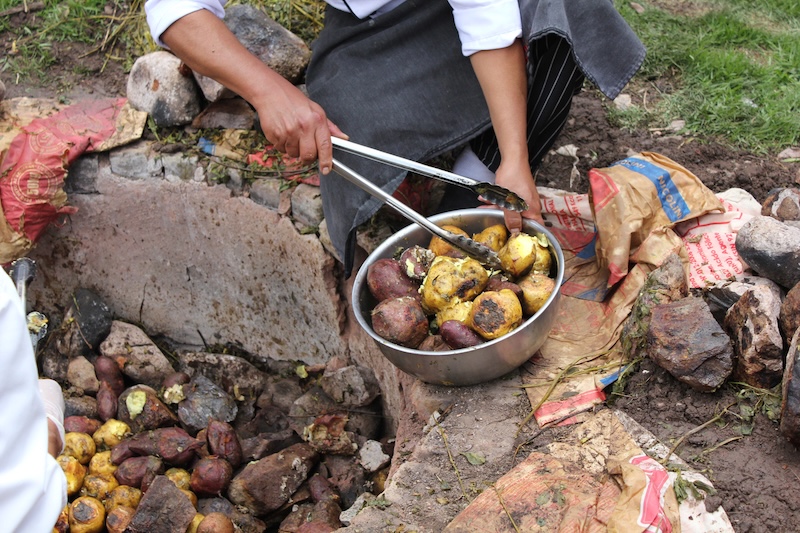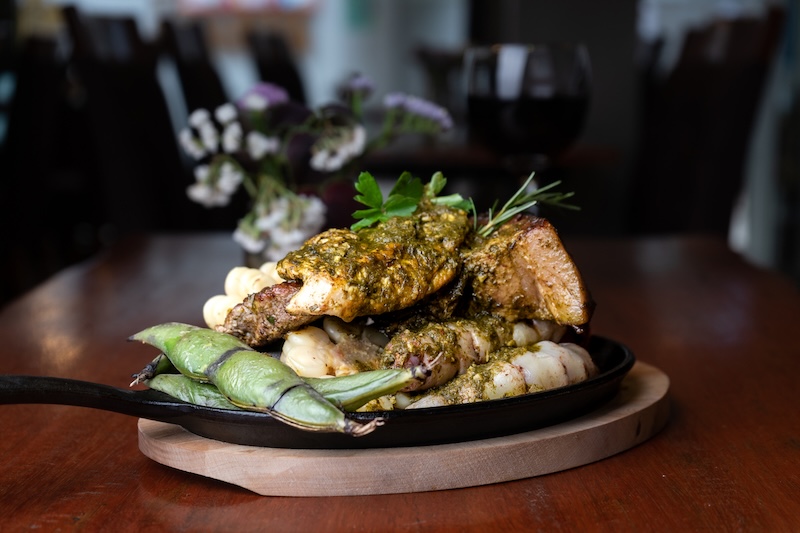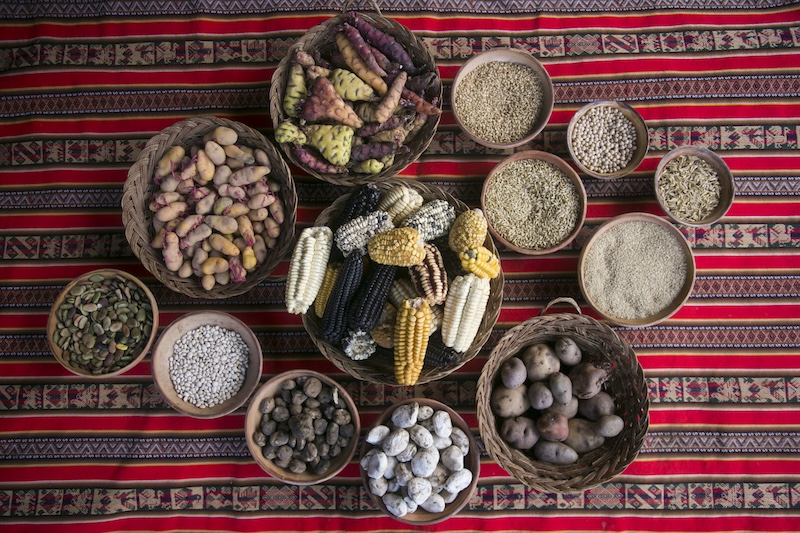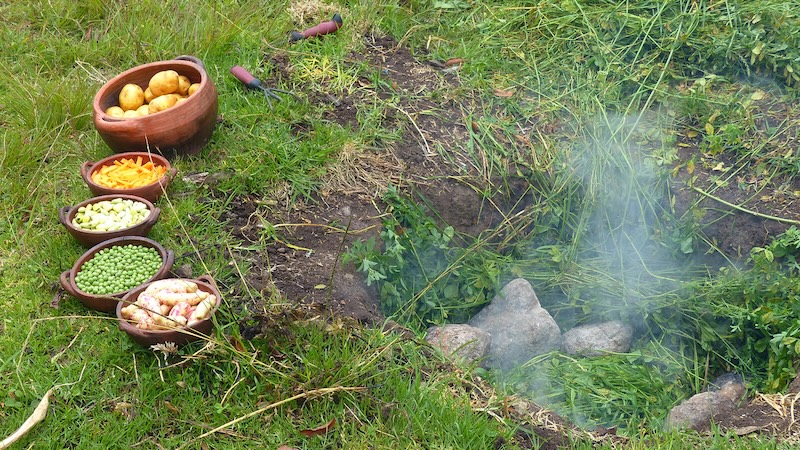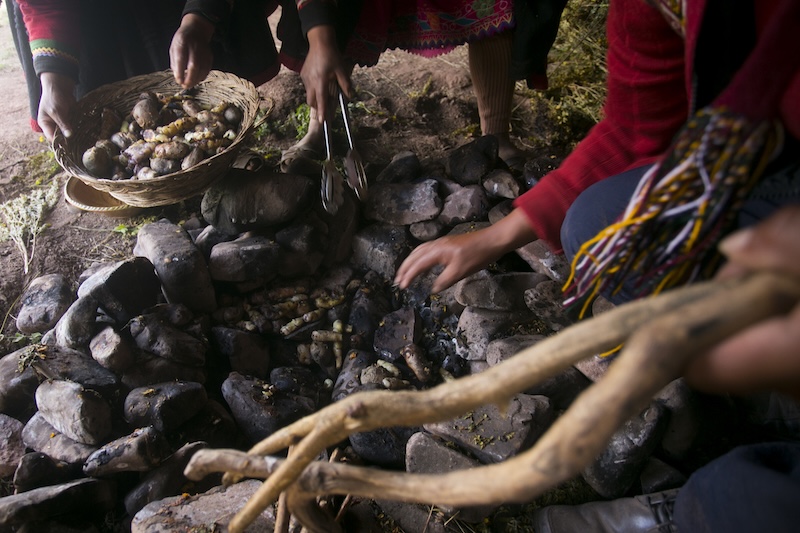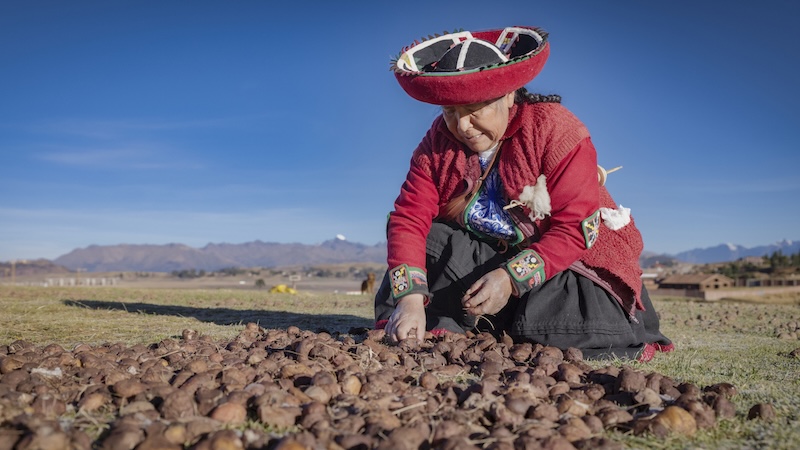Pachamanca is more than just a dish. It’s a journey into Peru’s rich cultural tapestry. This traditional meal, rooted in the Andes, offers a taste of history. Its name, derived from Quechua, means “earth pot,” reflecting its unique cooking method.
Pachamanca is a communal experience. It is often prepared for celebrations and gatherings. The process involves cooking in an earth oven, a technique passed down through generations.
This dish is a testament to the ingenuity of ancient cooking methods. It showcases the diverse ingredients of the Andean region, from marinated meats to native vegetables.
Pachamanca is not only about flavors but also about community and tradition. It connects people to their land and heritage, making it a culinary treasure.

What is Pachamanca?
Pachamanca is a traditional Peruvian dish, celebrated for its unique preparation method. It is a communal feast, perfect for gatherings and festivals. Unlike other meals, it is more than just food. It’s an event.
This dish is crafted using an earth oven, a cooking technique preserved by the Andean people. The oven is made by digging a hole in the ground and lining it with heated stones. The ingredients are layered inside, allowing the flavors to blend harmoniously.
Typically, Pachamanca includes a variety of marinated meats and Andean vegetables. Common ingredients are:
- Chicken, pork, or lamb
- Potatoes and corn
- Andean spices and herbs
The slow cooking process enhances the dish’s flavors, making every bite an aromatic experience. This makes Pachamanca more than just a meal. It’s a culinary delight that showcases Peru’s rich agricultural heritage.
The Origins and History of Pachamanca
Pachamanca has roots in the Inca Empire, showcasing Peru’s rich cultural and culinary past. The name “Pachamanca” is derived from the Quechua words “pacha” (earth) and “manca” (pot), meaning “earth pot.”
The dish was originally created to honor Pachamama, the Earth Mother, in Andean culture. This cooking method reflects a deep respect for nature and the earth’s bounty. By using earth’s natural elements, Pachamanca represents an organic connection between people and the land.
In ancient times, it was a sacred meal. It was consumed during significant agricultural festivities. Food was cherished as a gift from the gods and was shared among community members as a symbol of unity.
Today, Pachamanca remains a vital part of Peru’s gastronomic identity. It preserves ancient rituals while adapting to modern tastes. Not only does it highlight the ingenuity of Incan culinary practices, but it also continues to connect Peruvian people to their ancestors.
Key aspects of Pachamanca’s origins:
- Dates back to the Inca Empire
- Initially a sacred meal during agricultural festivities
- Highlights the blend of indigenous and colonial influences

Cultural Significance and Rituals
Pachamanca is more than just a dish; it’s a reflection of Andean culture and traditions. It’s a culinary symbol of community and togetherness. Traditionally, it is a communal event, strengthening bonds among participants.
Preparing Pachamanca is often accompanied by music and dance. These festivities are integral to the process, turning cooking into a joyous celebration. Moreover, the dish is frequently involved in rituals that honor Pachamama, reflecting ancient spiritual connections.
Important rituals and cultural practices associated with Pachamanca include:
- Celebration of Inti Raymi, a festival honoring the sun god
- Participation in local festivities, enhancing social bonds
- Incorporation of music and dance during preparation
Through Pachamanca, communities express gratitude for nature’s bounty. Its ritualistic preparation and consumption highlight the Peruvian philosophy of reciprocity and respect for the earth. The traditions surrounding Pachamanca support the preservation of cultural heritage for future generations.
Ingredients: A Celebration of Andean Bounty
Pachamanca showcases the rich biodiversity of Peru through its ingredients. The dish is a vibrant tapestry of colors and flavors from the Andes. Local resources are used to create a culinary masterpiece that connects diners to the land.
Marinated meats are the centerpiece of Pachamanca. The selection usually includes lamb, chicken, pork, and guinea pig. Each type of meat is imbued with traditional herbs and spices, such as huacatay and ají.
Typical ingredients found in Pachamanca include:
- Varieties of meat: lamb, chicken, pork, guinea pig
- Traditional spices: huacatay, ají
- Andean vegetables: potatoes, corn
The combination of these elements highlights the bounty of the region. Andean vegetables like potatoes and corn are essential, providing hearty textures and earthy flavors. Additional herbs and spices enhance the aroma, making Pachamanca a sensory delight.
Other Andean ingredients often include:
- Sweet potatoes
- Broad beans
- Native corn varieties
This vibrant mixture not only nourishes the body but also represents a deep reverence for nature’s gifts. Pachamanca is a tribute to Peru’s diverse ecosystems and agricultural heritage.

The Traditional Cooking Method: Pachamanca a la Tierra
Pachamanca is not just about flavors but also a unique cooking method. The phrase “Pachamanca a la tierra” describes this traditional technique. It means “earth pot” and involves cooking in an earthen oven.
The process begins with digging a hole in the ground. This pit serves as the oven for the meal. The next step is lining it with stones, which are heated over an open fire until red-hot.
Once the stones are ready, ingredients are placed in the pit. Layers of marinated meats and vegetables fill the space. The heat from the stones cooks the food slowly, imbuing it with rich flavors.
The pit is then covered with moist sacking or banana leaves, sealing in heat and aroma. A layer of earth is added on top to insulate the oven and trap more heat. This ancient method requires precision and patience, as it takes hours to cook the feast.
To prepare Pachamanca, follow these steps:
- Dig an earth oven
- Heat stones over a fire
- Layer marinated meats and vegetables
- Cover with leaves and earth
- Cook slowly, savoring every moment
This method highlights the Andean skill of using natural resources harmoniously. It’s a rustic art passed down through generations, connecting modern practices with ancient wisdom.
Step-by-Step: How Pachamanca is Prepared
Preparing Pachamanca is a communal event that requires teamwork and care. It begins with gathering fresh ingredients and organizing the cook’s tools.
First, select the meats, often a mix of chicken, pork, lamb, or sometimes guinea pig. Marinate the meats in a blend of spices, including huacatay and ají.
Next, assemble the vegetables. Potatoes and corn are staples, joined by Andean roots and beans. These will accompany the meats in the earth oven.
The pit must be prepared as the heart of Pachamanca’s cooking. Heat the stones in an open flame until they’re glowing. Line the pit with these hot stones to create the oven base.
Now, layer the ingredients in the pit. Start with meats, followed by layers of vegetables. Each component absorbs the essence of the earth.
Seal the pit with leaves and a layer of earth, ensuring heat retention. Cooking takes several hours, allowing the ingredients to harmonize in flavors.
Here’s a quick list of steps:
- Marinate meats
- Prepare vegetables
- Heat stones for the oven
- Layer ingredients in the pit
- Cover with leaves and earth
Each stage of preparation reflects respect for tradition and community, making Pachamanca a unique culinary event.

Regional Variations and Modern Adaptations
This traditional dish varies greatly across Peru, showcasing the country’s rich regional diversity. Each area adds its own touch by incorporating local ingredients.
In coastal regions, seafood occasionally replaces traditional meats, offering a unique twist. Meanwhile, jungle areas might blend exotic herbs for added complexity.
Modern adaptations are evolving too, as urban chefs experiment with Pachamanca’s timeless techniques. Some use traditional methods with innovative ingredients like quinoa or amaranth.
Here are a few variations:
- Coastal versions with seafood
- Jungle adaptations with exotic herbs
- Urban innovations with grains like quinoa
These variations ensure Pachamanca remains a living tradition, continually adapting while preserving its core identity rooted in the earth.
Pachamanca in Peruvian Festivals and Daily Life
It holds a special place in Peruvian celebrations and everyday moments. It frequently graces festivals, turning ordinary gatherings into extraordinary events.
During festivities like Inti Raymi, Pachamanca becomes a cultural highlight. Families and friends come together, sharing not only food but memories and traditions too.
In daily life, Pachamanca symbolizes unity and hospitality. Its preparation often marks community milestones or personal achievements.
Key occasions include:
- Inti Raymi, showcasing its cultural importance
- Family gatherings and reunions
- Celebrations of life milestones
This deep connection between Pachamanca and Peruvian life emphasizes its role as more than just a dish. It is a bridge, linking the past with the present.

Pachamanca in the World: Tourism and Global Recognition
It has captured the imagination of travelers and food lovers globally. Its traditional roots and unique cooking style offer an authentic culinary experience. Visitors to Peru eagerly seek out Pachamanca, not just for its flavors, but for a glimpse into Andean culture.
This dish has become a key feature in Peruvian culinary tours. Its growing popularity also brings attention to Peru’s diverse cultural heritage. It serves as a symbol of Peru’s rich and vibrant traditions.
Global Highlights:
- Featured in culinary tours
- Celebrated at international food festivals
- Showcased in global documentaries on traditional cooking methods
Through Pachamanca, Peru’s culinary art reaches beyond borders, inviting the world to celebrate its richness and depth.
Pachamanca PNG: Visuals and Representation
Pachamanca is as visually captivating as it is delicious. Images of this earth-cooked feast capture its rustic charm and cultural significance. They serve as a bridge, connecting digital audiences with Peru’s ancient culinary traditions.
Visual Elements:
- Vibrant dishes showcasing natural ingredients
- Earth ovens with steaming meats and vegetables
- Communal gatherings around a Pachamanca preparation
These images help convey the spirit and cultural depth of Pachamanca, offering a visual narrative of a proud tradition.

Why You Should Try Pachamanca
Pachamanca offers a taste of Peruvian heritage that transcends mere dining. Its unique preparation and flavors create a profound culinary experience.
Reasons to Try Pachamanca:
- Immerse in authentic Andean traditions
- Relish the diverse, indigenous ingredients
- Experience communal dining rituals
Each bite of Pachamanca connects you to Peru’s rich cultural landscape. This makes it a must-try for food enthusiasts.
Conclusion: Pachamanca as a Living Tradition
Pachamanca stands as a vibrant testament to Peru’s enduring culinary and cultural legacy. This ancient dish, with its roots in the earth, continues to thrive today.
By preserving Pachamanca, Peruvians celebrate their deep connection to nature and community. Its flavorful journey across generations illustrates a rich history woven into everyday life. It still evolves while remaining true to its origins. This living tradition, cherished and shared, reflects Peru’s gastronomic heart.


